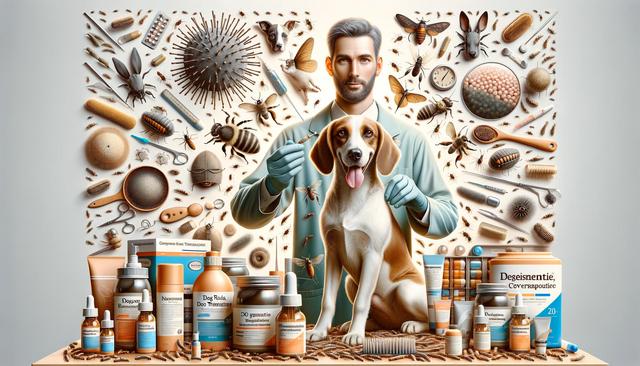
Your Guide to Safe and Effective Flea Treatments for a Healthier, Happier Dog
Understanding the Flea Life Cycle
To effectively combat fleas, it’s essential to understand their life cycle. Fleas go through four stages: egg, larva, pupa, and adult. The entire cycle can complete in as little as three weeks, depending on environmental conditions. Understanding this cycle helps in identifying the most opportune moments for intervention. Here are some critical points to consider:
- Flea eggs are laid on the host but quickly fall off into the environment, such as carpets or bedding.
- Larvae avoid light, making them challenging to spot, and they feed on organic debris.
- Pupae can remain dormant for weeks, making them resistant to many treatments.
- Adult fleas emerge from pupae when they detect vibrations or carbon dioxide, signaling a potential host is nearby.
By targeting multiple stages of the flea lifecycle, you can increase the efficacy of treatment efforts and reduce reinfestation risks.
Topical Treatments for Fleas
Topical treatments, often administered as spot-on products, are a popular choice for many dog owners. These treatments are applied directly to the dog’s skin, usually between the shoulder blades, and work by killing fleas upon contact. Here are some advantages of using topical treatments:
- They provide continuous protection, often lasting up to a month.
- Many formulations also repel other pests like ticks and mosquitoes.
- Topical treatments are generally safe when used according to the manufacturer’s instructions.
It’s crucial to follow dosing instructions carefully to avoid potential side effects. Additionally, refrain from bathing your dog or letting them swim for a couple of days before and after application to ensure the product remains effective.
Oral Flea Medications
Oral flea medications are a convenient and highly effective option for managing flea infestations. These medications usually come in the form of chewable tablets or pills and work by disrupting the flea’s nervous system, often killing them quickly. The benefits of oral medications include:
- Fast-acting relief for your pet, sometimes within hours of administration.
- No mess from topical applications, reducing the risk of accidentally washing off the product.
- Many oral medications also protect against other parasites, such as heartworms and intestinal worms.
Consult your veterinarian to determine the most suitable oral medication for your pet, as certain breeds may have different needs or potential sensitivities to specific ingredients.
Natural Remedies and Prevention Strategies
For those seeking alternatives to chemical treatments, several natural remedies and prevention strategies are available. While these methods might not be as immediately potent as conventional medications, they can be part of a comprehensive flea management plan. Consider the following natural approaches:
- Regularly grooming your dog with a flea comb can help remove fleas and their eggs.
- Essential oils, such as lavender or cedarwood, can act as natural repellents when diluted and used correctly.
- Keeping your home clean, including washing bedding and vacuuming carpets, disrupts the flea lifecycle.
Natural remedies require more frequent application and monitoring but can be a beneficial supplement to other treatment methods.
Consulting with Your Veterinarian
When managing fleas, your veterinarian is an invaluable resource. They can provide tailored advice based on your dog’s specific needs, health conditions, and lifestyle. Veterinarians can also diagnose potential flea-related health issues, such as allergies or tapeworms, that may arise from infestations. Key considerations during your vet consultation include:
- Discussing your dog’s overall health and any allergies to ingredients in flea treatments.
- Considering the best flea prevention plan based on geographic location and seasonal flea activity.
- Understanding the importance of year-round prevention, even during colder months when fleas are less active.
Regular check-ups ensure that your flea prevention strategy remains effective and aligned with your dog’s health needs.
Conclusion: Achieving a Flea-Free Environment
Maintaining a flea-free environment is crucial for your dog’s health and comfort. By understanding the flea life cycle, choosing effective treatments, and consulting with your veterinarian, you can create a comprehensive plan to manage and prevent flea infestations. Combining various approaches, including both conventional and natural methods, will provide robust protection for your pet. Keep your dog’s environment clean and follow a consistent treatment regimen for the best results, ensuring your furry friend remains happy and healthy throughout the year.